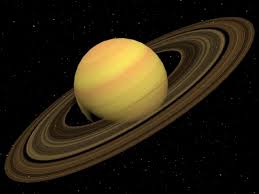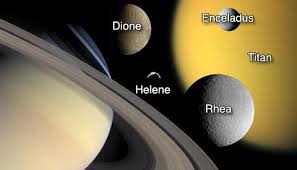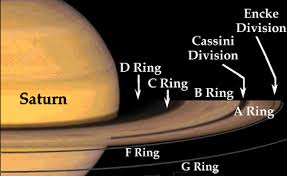Overview
Saturn is the sixth planet from the Sun. It is a gas giant, similar to the planet Jupiter, and is the second-largest planet in the Solar System. It has nine rings made of ice, rocks, and dust, as well as over 60 larger moons and hundreds of moonlets in the rings.
The Planet Saturn
Saturn is a huge flattened sphere with a radius 9 times of planet Earth and a volume 95 times the Earth’s. It consists mostly of hydrogen and helium, and its density is less than water. Like Jupiter, it has a very hot, rocky core, surrounded by metallic hydrogen under pressure, liquid hydrogen under pressure, transitioning to gaseous hydrogen. Its atmosphere is made of over 96% hydrogen, over 3% helium, with clouds of ammonia, acetylene, propane, and methane. It has high winds, over 1800 km/hr., and average temperatures between -120°and -185°C. It is about 9 times the distance of the Earth to the Sun, 1.4 billion km, with an average 10 ½ hour day. Saturn takes about 29 ½ years to complete its orbit around the Sun.
Moons of Saturn
Titan is the largest moon, 50% larger than Earth’s moon, with a dense atmosphere made of mostly nitrogen, ethane, and methane. It has hydrocarbon lakes as well as a possible liquid layer under a murky surface. Other large moons include Dione, Tethys, Mimas, Enceladus, and Rhea. The moon Dione has two moons of its own. Many other smaller moons orbit the planet Saturn.
Rings of Saturn
The best-known feature of the planet Saturn are its rings made of ice. They were sighted by Galileo through his telescope in 1610, and detailed observations showed details of their nature. They appear to be anywhere from 10 m to 1 km thick, and form a complex structure of water ice, particles of rock with different sizes, and a thin atmosphere all its own. Photographs from space probes such as Voyager and Cassini show a complex structure of rivulets, ringlets, and waves.
Exploration of Saturn
Besides gathering pictures of the ring system, space probes have studied the moons, as well as the planet itself. Voyagers I and II sent back detailed photographs of the planetary system. The Cassini space probes were able to explore many features of weather systems in Saturn’s atmosphere, liquid lakes on Titan and Enceladus, newly formed moonlets within the rings, leading to further exploration.
Interested in science tutoring services? Learn more about how we are assisting thousands of students each academic year.
SchoolTutoring Academy is the premier educational services company for K-12 and college students. We offer tutoring programs for students in K-12, AP classes, and college. To learn more about how we help parents and students in Cold Springs, NV: visit Tutoring in Cold Springs, NV




